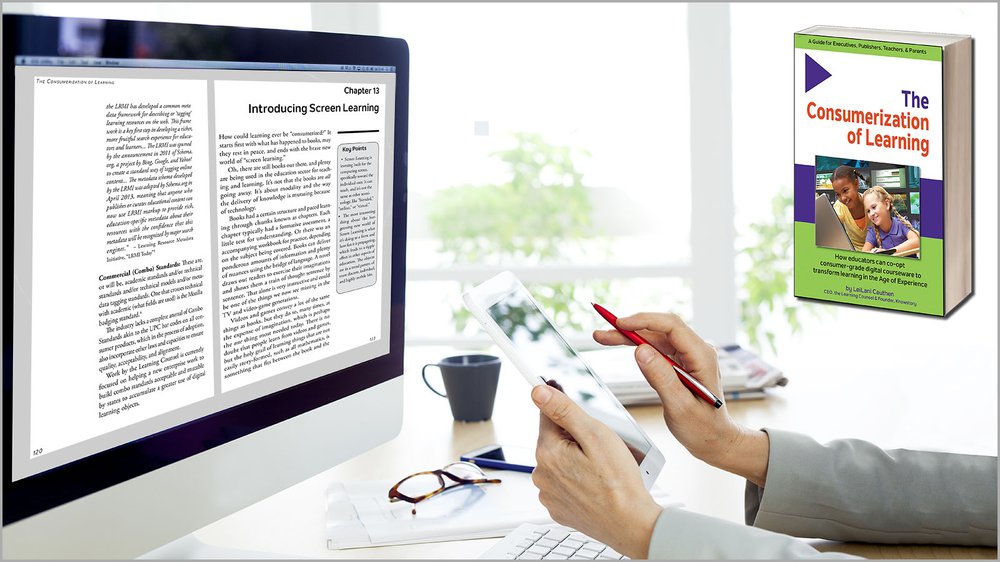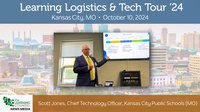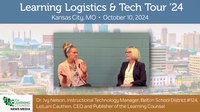Excerpt from The Consumerization of Learning by LeiLani Cauthen
How could learning ever be “consumerized?” It starts first with what has happened to books, may they rest in peace, and ends with the brave new world of “screen learning.”
Oh, there are still books out there, and plenty are being used in the education sector for teaching and learning. It’s not that the books are all going away. It’s about modality and the way the delivery of knowledge is mutating because of technology.
Books had a certain structure and paced learning through chunks known as chapters. Each chapter typically had a formative assessment, a little test for understanding. Or there was an accompanying workbook for practice, depending on the subject being covered. Books can deliver ponderous amounts of information and plenty of nuances using the bridge of language. A novel draws out readers to exercise their imaginations and shows them a train of thought sentence by sentence. That alone is very instructive and could be one of the things we now see missing in the TV and video-game generations.
Videos and games convey a lot of the same things as books, but they do so, many times, at the expense of imagination, which is perhaps the one thing most needed today. There is no doubt that people learn from videos and games, but the holy grail of learning things that are not easily story-formed, such as all mathematics, is something that fits between the book and the full video or game world. That something has come into being and is rapidly populating the learning landscape.
It’s called “Screen Learning.” Not to be confused with online learning, which is defined very loosely as an online course that requires guidance by a teacher and may have recorded lectures in it along with documents and instructions; or distance learning, which is even more loosely defined as learning, across a distance from an instructor-led course. It’s also not “blended” or “personalized” or any of the other terms the industry has used to modify the existing classroom scene.
Key Points
• Screen Learning is learning built for the computing screen, specifically toward the individual user. It can teach, and it’s not the same as other terminology, like “blended,” “online,” or “virtual.”
• The most interesting thing about the burgeoning new world of Screen Learning is what it’s doing as a form and how fast it is propagating, which leads to a ripple effect in other aspects of education. The objects are in a trend pattern of more discrete, individual, and highly mobile bits.
Screen Learning is both in and outside the context of the classroom and teacher-learner paradigm.
Screen Learning is also both simpler and more complex than other terms related to imbuing education with tech.
It is learning built for the computing screen. That’s it. It doesn’t care where you are as a learner or if a teacher is even there, necessarily, although it doesn’t replace a teacher in every sense. It’s straight up built for the user. For example, see how Microsoft’s Minecraft is built, marketed, and sold to kids who learn elementary code concepts from using it.
Screen Learning is a content delivery mechanism which a teacher has had as only one of many functions in the past. It usually combines reading and video embedding and can get as deep as a full virtual world with interactivity of most of its elements. It could be built to talk to you and be personalized by the student, and sometimes individualized by the teacher so that the student view to lessons is narrowed or “gated” in order that a particular student gets a precise set of lessons. It may require certain teacher inputs and teacher creativity within the framework of its master conception.
Being built for the user is where Screen Learning is abruptly, but subtly, turning learning into the next big thing for commercialization. Because it also exactly matches the goals of customized learning so that every student gets exactly what they need, it’s also dovetailing into what institutions want to use but are not quite sure how to leverage in their current context.
“The industry of education itself has long been in a dialog about what the small bits are, be they “artifacts” or “concepts” or “elements,” and whether or not they are performing technologically (doing something) in order to qualify for “object” status versus being lifeless words or pictures, which would be mere “content” or “resources.”
For our purposes, we are using “object” in the computer programming definition of objects, which stems from: “In Object Oriented Programming (OOP), the word ‘object’ has special meaning: objects are defined as a specific way of organizing source code.” 1
The most interesting thing about the burgeoning new world of Screen Learning is what it’s doing as a form and how fast it is propagating, which leads to a ripple effect in other aspects of education. Consider that there are an estimated 7,000 digital curriculum and content companies or publishers, and that’s before adding in all of the one-off app builders that are sometimes one-man shops. These companies, along with teachers working on their own, have already created tens of millions of learning “objects” or bits of learning. Think in terms of “chapters” or “chunks” of knowledge, like how to add and subtract fractions, or perhaps the Declaration of Independence. The objects are in a trend pattern of more discrete, individual, and highly mobile bits.
In an attempt to define the characteristics of what a “learning object” is, I’ve created this summary list, if for no other reason than to sort the subject out in my own head:
• An object may explain a single part of knowledge such as understanding pyramid structure.
• An object can be interactive in and of itself.
• The objects can be multi-sensory, incorporating touch-screens and sound.
• Some objects are found in collections of like things, like videos and short games, and e-books or e-chapters.
• Some objects are knowledge artifacts built into full courses, with a scope and sequence pre-built for those individual bits until a pinnacle or totality of knowledge in that topic is achieved.
• Some courseware objects are single lesson and others are full-coverage of a subject with multiple lessons that can be spread out in incremental amounts of time, mirroring a daily classroom need.
• Some objects come tethered together with assessments, and some are teaching as an assessment.
• Many times, the objects in courseware have intersection points where teachers can interact and set controls for the student.
• Sometimes the student self-controls the sequence in a randomized pattern, such as book collection sites.
• Many times, the courseware and collections of objects offer analytics showing how a student is doing to the student and/or to the teacher. These are sometimes called “solutions” by the software industry.
• Sometimes the learning object is a game, offering all the typical game maneuvers, like rewards, penalties, and achievement levels.
• Learning objects can even be highly stylized with actions, animations, mechanisms, aesthetics, controls, individualizations, instructs, and more. Using developer and designer skills, they can include ideal user interface/user experience (UI/UX).
• Some of the learning objects are apps just like consumer-side game apps. Most of them are one-offs, like downloading a single song.
• The objects may be accrued just like consumer-world shopping cart technology or iTunes libraries and cut-up and rehashed into a new object for new “playlists” of knowledge or “mixes” of learning.
• The learning objects are increasingly meta-tagged as aligned to a myriad number of Standards in the K-12, higher ed, or professional learning certifications world. The higher education world and some of the K-12 world require learning objects to have meta-tags or they’re not even considered an “object.” This is because, unlike the K-12 market in the U.S., which has largely been creating learning objects to fit into the existing classroom model where teacher and learner are physically together. The higher-ed world is already more solidly into consumable learning objects that operate nearly independently of the context of communication between teacher and learner.
That final point, that the learning object provides instructs in such a way that the learner knows they know the subject at the end (i.e., accomplished a standard) is a growing trend. This is perhaps one of the most significant redirects away from how teaching and learning has been in the past. When a learner knows they know, intermediation by another, as in a teacher or institution, becomes irrelevant for them. Testing becomes irrelevant for them. They already know and may or may not care to prove it to others, especially when demonstration of mastery is on-the-job or enhanced contribution.
In fact, one of the constraints of the consumerized learning trend is a perceived requirement for grades, diplomas, and degrees that require institutional accreditation. This may be solved when trusted software says via built-in summative assessment that a grade or credit has been earned, and it does so in a publicly consumable way on behalf of the learner that can be displayed at will. Since ultimately the utility of a grade, degree, or diploma relies on the trust of the inspecting party, the college, or employer, so the rise of trusted third-party issuers could become a normal and necessary reality.
Major brands like Cisco, Microsoft, Disney, and many others already have certifications that have meaningful value to anyone.
Places like Houston Independent School District in Houston, Texas have a Learning Management System that houses over two million digital learning objects. Other districts are similarly situated or well on their way. The textbook, while still important in many places, was almost never used in its entirety, and those unused chapters were considered wasteful. In the transition to digital, teachers wanted “chunked” content so they could mix and match at will. The industry responded with delivering exactly what was asked for, in large volume. Industry also took the opportunity to envelop that content into scope and sequenced courseware and sell it as “remedial” to schools and parents online.
That was an easy entrance into schools: offering extra practice and help for students falling behind. Screen Learning was a perfect fit. It did not require much teacher intervention and solved a problem. As education became ever-more complicated with new standards and accountability demands, increasing reliance on Screen Learning allowed schools to start thinking about it as core learning, not just supplemental. Now the high-engagement coupled with multi-sensory interactions of Screen Learning meets digitally native students exactly right, and increasingly has the heightened scores to prove it.
Commercial World vs. Education World
The problem is that the uptake by schools has been too slow for the commercial world. Upon invention of these costly learning objects, publishers have had to try to earn in any way that they could. Many of the largest have been nearly gutted, as non-spending of billions of expected dollars by schools to publishers caused cutting of staff and resources. Many times, the talent who were cut simply went out and started new software companies, now using superior knowledge curation skills coupled with new programmers and software architects. In the meantime, schools almost universally went with their own teachers, building homegrown learning objects, the vast majority of which are mere documents, links, or recorded lectures. While these may be pedagogically useful, they aren’t necessarily meeting students with what they expect given all their other exposures to consumer-grade technologies.
In fairness, with the content world in fractured small bits, publishers weren’t ready for a while, and no educational institution was structured to curate and sequence every one of thousands of standards, plus build all the tests. The ordered world of education began to fall into chaos and is still falling, with leaders and politicians struggling to hold together a semblance of the old “workable” structure.
While the consumer world keeps gaining ground – and companies and products like ABCmouse, with its billion-dollar market valuation, LeapFrog, PBS, History Channel, Disney, Amazon, and others suit up for the coming takeover – teachers and schools using no Screen Learning, or no tech at all, are not only behind, but many have little understanding of the quantum shift that is coming their way.
Definitions of Terms
With lessons learned on the road, there are a lot of terms bandied about concerning the new modalities and new pedagogy. Here are some definitions of terms which tend to be used interchangeably but do need clarification as we move forward.
Screen Learning: Learning built for the computing screen to deliver content for a user with fancy digital aspects. It doesn’t necessarily use or fully replace a teacher, but could be used in a classroom or outside of it as an individual learning object or full courseware for mastery of the content. Screen Learning assumes an “objectized” or “chunked” view of subjects and topics much like a single video, short-form game (“gamelet”) or app that might be on the history of the Gettysburg Address by Abraham Lincoln versus a whole course on the Civil War or America’s Founding Fathers. It may be a digital journey through multiple topics within a subject in a virtual environment that may have game and animated, storied features, taking students through multiple lessons that are presented based on that courseware’s sequence. The screen learning may even be adapted to the individual student via an intelligent learning engine that understands that student’s level of need, presenting alternatives to the same lesson for reading level or practice to ensure mastery.
Screen Learning Time: Refers to the classroom time dedicated to the use of Screen Learning of digital curriculum, content, or courseware on devices.
Blended Learning is a broad definition pertaining to doing both in-person and online learning in a mix custom for a class by a teacher. Also called hybrid learning and mixed-mode. It assumes a teacher.
Online Learning may be a part of a course syllabus or the entire course, but it generally assumes a course context, not a single-object or discrete knowledge lesson as Screen Learning can do. It may be from an outside institution or entity as a requirement for part or all of a larger learning journey such as Udemy, Coursera, or Khan Academy courses while attending a K-12 school. eLearning assumes any digital object and is a term also widely used in the corporate training industry.
Distance Learning assumes geographic distance between the teacher and learner and assumes a teacher-led model.
Flipped Learning assumes a physical environment locus and is a teacher-led model.
Individualized Learning assumes teacher interposition within the learning inclusive of levels allowed into within the software. This is a trait of some Screen Learning.
Personalized Learning assumes self-direction, which is a trait of Screen Learning, but teachers can also interpose as guides by individualizing the software view. Personalized Learning Environments are software structured to allow a student to self-direct. These are different than Virtual Learning Environments in that the Virtual ones typically would model traditional education, just in a web-based virtual environment but with a teacher/instructor.
1 Source: https://en.wikibooks.org/wiki/Alevel_Computing/AQA/Paper_1/Fundamentals_... oriented_programming
**
If you would like to learn more and dive further into The Consumerization of Learning the book is available in Kindle and paperback formats.











